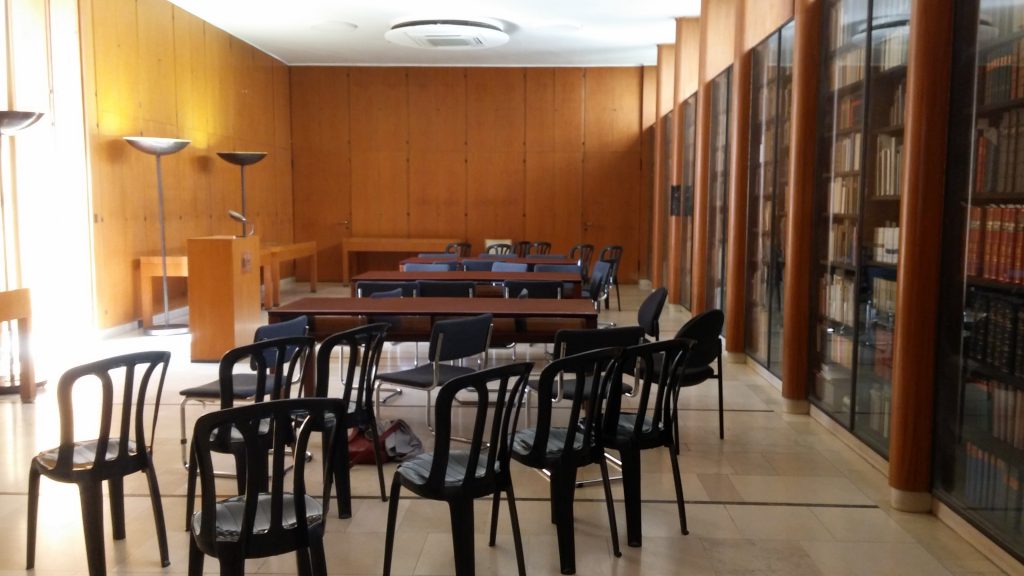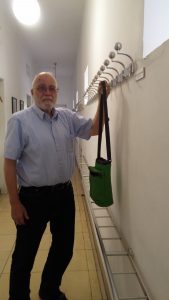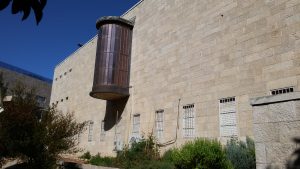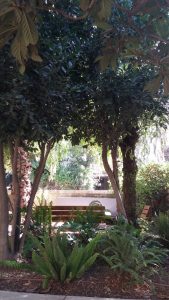
Schocken Library, Jerusalem, conference room. Books are stored in glass fronted cabinets on right and in locked cabinets of the far wall and the wall on the left.
A few years ago, on a tour of the Rehavia neighborhood of Jerusalem, we walked through a security gate and past the entrance of the Prime Minister’s (PM) Residence. Further down Balfour Street, but still within the secure area, guide pointed out the Schocken Library. It’s a private research facility that now belongs to the Jewish Theological Seminary.
The library is an unimpressive building—two stories, no balconies, square in front. Aside from a strange tall curved window sticking out of the south side, the building looked neither architecturally nor historically interesting. I almost forgot about it.
But recently, the Schocken Library was open for public tours during the “Houses from Within” event. Allen and I went, and ended up seeing more than just a library.
Zalman Schocken’s rare book collection
Zalman Schocken was not a religious man. As the publisher and a patron of Martin Buber, he had read Buber’s edition of Rabbi Nachman of Breslov’s stories. The book changed his view of Judaism from a set of rigorous practices to Judaism as a tradition and a culture.
So Schocken started collecting Jewish books. He didn’t have a specific goal in mind, but every time he heard about an old book he bought it. He started in his home town of Zwickau, Germany, and then widened his search to all of Germany. Eventually he collected books frolm all over Europe, and even in British Mandatory Palestine.
By 1932, he had a substantial collection of rare books. Conditions in Germany were becoming difficult for Jews. He needed a permanent home for his collection. What better place could there be for a vast collection of books about Jews and Judaism than Jerusalem?
At that time, Eric Mendelsohn, one of the most renowned architects in the world, had recently made aliyah. He was happy to accept Schocken’s commission to design both a house, to be called Villa Schocken, and a library for the book collection in the new Rehavia neighborhood.
By British law, the exteriors of buildings in Jerusalem had to be the local cream or pink limestone, today called “Jerusalem stone.” That law is still in force, and gives the city its uniform appearance. In the 1930s, all buildings were constructed of stone blocks. But Mendelsohn’s buildings were concrete faced with limestone.
The Schocken Library
After a brief introduction about Schocken and Mendelsohn, our guide Alon, led us through the building. He mentioned several times that

The coatroom, with a shallow gutter to carry away water that drips from raincoats and umbrellas.
Mendelsohn always combined practicality with design. Alon showed us the cloakroom in the back hall. The line of coat hooks along the wall is not unusual, nor is the grid for umbrellas. However, I was impressed by the small gutter running along wall to channel the water that dripped from coats and umbrellas. The polished stone floors found in most Israeli buildings are slippery when wet, so this small detail is important. The drain seems like such an obvious idea. Why don’t more places have drains built into coat rooms, so that rain water doesn’t get tracked into the rooms?
On the second floor is the large conference room/library, which still looks as it did in the 1940s. The long north side of the room features glass-fronted shelves packed with old books. A row of windows runs along the top of these cases. The other three walls are locked wooden cabinets, from floor to ceiling. In the middle of the long wall opposite the glass fronted bookcases, a glass-walled alcove filled with bright sunlight juts out from the room.

The conference room alcove, as seen from the south side of the Schocken Library building. While allowing plenty of light into the room, it does not allow any direct sunlight to hit the rare books.
The room highlights Mendelsohn’s concern for combining the aesthetic and the practical. Direct sunlight can damage old books, and the room was designed so the sun would not shine directly on them.
Nonetheless, the room was full of natural light. The east and west walls of the room have no windows. The high windows above the bookcases allow indirect northern light to enter the room. Because the alcove faces south, sunlight floods it all day. Its shape, however, prevents direct sunlight from touching the books, no matter if they are on the shelves or one of the tables.
The line of the wooden dividers in the bookcases continues across the room as dark stripes in the pale stone floor. On the other side of the room, the supports of the wooden cabinets continue the line up to the ceiling. The locked wood cabinets hold more books.
Alon called an elderly man to the lectern. After introducing himself as Danny, he showed us two photos. The first showed him at age five sitting on the front steps of the library. He explained that his mother had been

The garden in front of the building.
the librarian, and he often came to play.
The second photo was of a model of the area in the 1940s that his father, an engineer, had constructed of small blocks. It showed the Villa Schocken, its spacious gardens, and Balfour Street. Because of all the construction in the last seventy years, Danny had to run his finger along each street to orient us. Then he pointed to the corner of Villa Schocken. “This is where my family lived.”
When we walked out gate, Danny’s friend suggested they go see the building where he had lived as a child. He demurred—the building had been changed, it was in the compound of the Prime Minister’s house, the guards wouldn’t let them in. But she insisted. What would it hurt if they asked?
They agreed when I asked if we could accompany them.
Villa Schocken
To leave the secured area, we had to go past a chayal (male soldier), a chayelet (female soldier), and a security guard which, of course, shouldn’t be a problem. However, the building Danny wanted to show us sat within the secured area. That should not have been a problem either, because the area he wanted to enter was on the other side of a wall that divided the former Villa Schocken from the Prime Minister’s residence.
The friend went to the soldiers and explained we had just toured the Schocken Library. She pointed at Danny and said that he wanted to show us where he grew up.
Danny showed them the photo of his father’s model. The soldiers peered at it, and after turning it upside down, they identified the streets.
The security guard asked to see the other photo, and Danny handed it to him. The young man looked at the picture of the small boy and asked, “This is you?”
The friend answered, “What, you can’t identify him?”
The soldiers looked at the photo of the five year old, at the 85 year old man, and laughed.
A moment later, the chayelet, still looking at the photo, exclaimed, “That’s the library over there!”
Danny had established his credibility. Now he had their full attention. They all wanted more details. Danny explained that his father, an engineer, had built the model. He pointed first to the photo, and then at the dilapidated building to our right, and said he had been born right there, in that room. The family had lived there until 1944 when the British took over the property. While the British were in charge, Jews had not been allowed in the area.
After the British left and the state was established, the building had been used as school. Later, it became a music academy. Now it was simply an abandoned building.
The soldiers let us approach the building. It was tricky going; like many abandoned properties, it was surrounded by a collection of trash. We picked our way through old bottles, bits of wire, and discarded paper cups, to the ground floor window, and peered through the dirty glass. The room we saw was large. Papers were strewn all over the floor, as if it had been ransacked by someone looking something valuable. This had been the main room used by Danny’s family.
He carefully made his way to look in a second window. “This was my room,” he said.
The guards had not followed us. They must have deemed us harmless. As we exited the area, they nodded at us.
I wondered what they would tell their friends that evening. No, nothing exciting happened at the PM’s place—no terrorists (Thank God!), no obnoxious demonstrators today. Just a bunch of old people who came to see where one of them used to live. But the routine had unexpectedly changed. A boring shift guarding the small side entrance to the street along the PM’s residence, had turned into an interesting day.